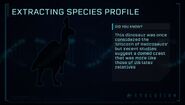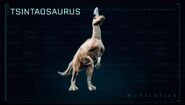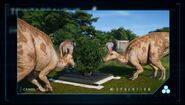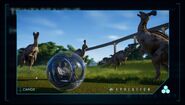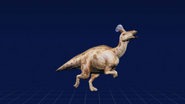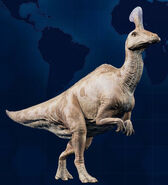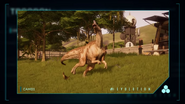(Adding categories) |
No edit summary |
||
| (6 intermediate revisions by 5 users not shown) | |||
| Line 9: | Line 9: | ||
|birth type = Egg |
|birth type = Egg |
||
|game = ''[[Jurassic World: Evolution]]'' |
|game = ''[[Jurassic World: Evolution]]'' |
||
| − | }}'''''Tsintaosaurus''''' ("Qingdao lizard", after the old transliteration "Tsingtao") is a genus of hadrosaurid dinosaur from the Late Cretaceous Period of China. It reached lengths of up to 27 feet long, and weighed up to 2.5 tons, or 5,000 pounds. |
+ | }}'''''{{W|Tsintaosaurus}}''''' ("Qingdao lizard", after the old transliteration "Tsingtao") is a genus of hadrosaurid dinosaur from the Late Cretaceous Period of China. It reached lengths of up to 27 feet long, and weighed up to 2.5 tons, or 5,000 pounds. |
A hadrosaur, ''Tsintaosaurus'' had a characteristic 'duck bill' snout and a battery of powerful teeth which it used to chew vegetation. ''Tsintaosaurus'', like most hadrosaurs, probably traveled in herds and was semi-quadrupedal and bipedal, meaning it can walk and run on two legs and four legs under certain times. |
A hadrosaur, ''Tsintaosaurus'' had a characteristic 'duck bill' snout and a battery of powerful teeth which it used to chew vegetation. ''Tsintaosaurus'', like most hadrosaurs, probably traveled in herds and was semi-quadrupedal and bipedal, meaning it can walk and run on two legs and four legs under certain times. |
||
| Line 22: | Line 22: | ||
==Games== |
==Games== |
||
===''[[Jurassic World: Evolution]]''=== |
===''[[Jurassic World: Evolution]]''=== |
||
| − | ''Tsintaosaurus'' |
+ | ''Tsintaosaurus'' appears in ''[[Jurassic World: Evolution]]''. Its coloration is mainly tan with dark brown patterning all over the body, with the top of the crest being purple. The shape of the animal's crest is based on its modern reconstructions. |
<gallery> |
<gallery> |
||
| Line 32: | Line 32: | ||
Screenshot 2018-05-12 at 6.18.07 PM.png|''Tsintaosaurus'' behind an ''[[Edmontosaurus]]'' while both are behind an ''[[Ankylosaurus]]'' |
Screenshot 2018-05-12 at 6.18.07 PM.png|''Tsintaosaurus'' behind an ''[[Edmontosaurus]]'' while both are behind an ''[[Ankylosaurus]]'' |
||
TsintaosaurusMain.jpg |
TsintaosaurusMain.jpg |
||
| + | Screenshot 2018-11-19 at 2.40.05 PM.png |
||
</gallery> |
</gallery> |
||
| + | |||
| + | ==Navigation== |
||
| + | {{SpeciesNavBox}} |
||
[[Category:Late Cretaceous Dinosaurs]] |
[[Category:Late Cretaceous Dinosaurs]] |
||
[[Category:Jurassic World: Evolution dinosaurs]] |
[[Category:Jurassic World: Evolution dinosaurs]] |
||
| Line 39: | Line 43: | ||
[[Category:Dinosaurs Discovered in the 1950s]] |
[[Category:Dinosaurs Discovered in the 1950s]] |
||
[[Category:Dinosaurs of Asia]] |
[[Category:Dinosaurs of Asia]] |
||
| − | [[Category:Herbivores]] |
||
[[Category:Ornithischia]] |
[[Category:Ornithischia]] |
||
| − | [[Category:Pages Needing Attention]] |
||
Revision as of 21:25, 13 January 2019
Tsintaosaurus ("Qingdao lizard", after the old transliteration "Tsingtao") is a genus of hadrosaurid dinosaur from the Late Cretaceous Period of China. It reached lengths of up to 27 feet long, and weighed up to 2.5 tons, or 5,000 pounds.
A hadrosaur, Tsintaosaurus had a characteristic 'duck bill' snout and a battery of powerful teeth which it used to chew vegetation. Tsintaosaurus, like most hadrosaurs, probably traveled in herds and was semi-quadrupedal and bipedal, meaning it can walk and run on two legs and four legs under certain times.
Like many hadrosaurs, Tsintaosaurus sported a crest on its head. It was originally believed to point forward from its forehead, giving it the nickname "Unicorn of the Cretaceous". More recent discoveries suggest the crest instead pointed backwards and was comparable to its close relative, Lambeosaurus.
| Wikipedia has a more detailed and comprehensive article on Tsintaosaurus |
Games
Jurassic World: Evolution
Tsintaosaurus appears in Jurassic World: Evolution. Its coloration is mainly tan with dark brown patterning all over the body, with the top of the crest being purple. The shape of the animal's crest is based on its modern reconstructions.


